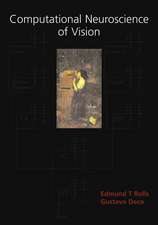Neural Principles in Vision: Proceedings in Life Sciences
Editat de F. Zettler Contribuţii de D.L. Alkon Editat de R. Weileren Limba Engleză Paperback – 17 noi 2011
Din seria Proceedings in Life Sciences
- 15%
 Preț: 646.75 lei
Preț: 646.75 lei - 18%
 Preț: 952.26 lei
Preț: 952.26 lei - 15%
 Preț: 637.28 lei
Preț: 637.28 lei - 18%
 Preț: 960.61 lei
Preț: 960.61 lei - 15%
 Preț: 648.24 lei
Preț: 648.24 lei - 15%
 Preț: 632.70 lei
Preț: 632.70 lei - 15%
 Preț: 654.43 lei
Preț: 654.43 lei - 15%
 Preț: 635.80 lei
Preț: 635.80 lei - 18%
 Preț: 959.50 lei
Preț: 959.50 lei - 15%
 Preț: 650.37 lei
Preț: 650.37 lei - 15%
 Preț: 636.45 lei
Preț: 636.45 lei - 15%
 Preț: 644.49 lei
Preț: 644.49 lei - 15%
 Preț: 639.08 lei
Preț: 639.08 lei - 15%
 Preț: 641.53 lei
Preț: 641.53 lei - 15%
 Preț: 664.61 lei
Preț: 664.61 lei - 5%
 Preț: 721.77 lei
Preț: 721.77 lei - 15%
 Preț: 652.49 lei
Preț: 652.49 lei - 5%
 Preț: 718.82 lei
Preț: 718.82 lei - 15%
 Preț: 636.80 lei
Preț: 636.80 lei - 15%
 Preț: 646.43 lei
Preț: 646.43 lei - 15%
 Preț: 649.22 lei
Preț: 649.22 lei - 18%
 Preț: 1390.11 lei
Preț: 1390.11 lei - 18%
 Preț: 956.33 lei
Preț: 956.33 lei - 15%
 Preț: 643.48 lei
Preț: 643.48 lei - 15%
 Preț: 641.38 lei
Preț: 641.38 lei - 15%
 Preț: 642.03 lei
Preț: 642.03 lei - 15%
 Preț: 640.24 lei
Preț: 640.24 lei - 15%
 Preț: 651.34 lei
Preț: 651.34 lei - 15%
 Preț: 649.39 lei
Preț: 649.39 lei - 5%
 Preț: 714.06 lei
Preț: 714.06 lei - 15%
 Preț: 640.37 lei
Preț: 640.37 lei - 15%
 Preț: 664.11 lei
Preț: 664.11 lei -
 Preț: 492.59 lei
Preț: 492.59 lei - 18%
 Preț: 945.47 lei
Preț: 945.47 lei - 15%
 Preț: 647.73 lei
Preț: 647.73 lei - 18%
 Preț: 942.01 lei
Preț: 942.01 lei - 18%
 Preț: 943.57 lei
Preț: 943.57 lei - 15%
 Preț: 639.41 lei
Preț: 639.41 lei - 5%
 Preț: 726.15 lei
Preț: 726.15 lei - 15%
 Preț: 641.03 lei
Preț: 641.03 lei - 5%
 Preț: 707.33 lei
Preț: 707.33 lei - 15%
 Preț: 647.27 lei
Preț: 647.27 lei - 15%
 Preț: 638.57 lei
Preț: 638.57 lei - 15%
 Preț: 645.79 lei
Preț: 645.79 lei - 15%
 Preț: 654.12 lei
Preț: 654.12 lei - 15%
 Preț: 652.31 lei
Preț: 652.31 lei - 18%
 Preț: 946.72 lei
Preț: 946.72 lei - 15%
 Preț: 637.28 lei
Preț: 637.28 lei - 5%
 Preț: 718.46 lei
Preț: 718.46 lei - 15%
 Preț: 653.33 lei
Preț: 653.33 lei
Preț: 650.86 lei
Preț vechi: 765.72 lei
-15% Nou
Puncte Express: 976
Preț estimativ în valută:
124.54€ • 130.36$ • 103.66£
124.54€ • 130.36$ • 103.66£
Carte tipărită la comandă
Livrare economică 31 martie-14 aprilie
Preluare comenzi: 021 569.72.76
Specificații
ISBN-13: 9783642664342
ISBN-10: 3642664342
Pagini: 448
Ilustrații: X, 432 p.
Dimensiuni: 170 x 244 x 24 mm
Greutate: 0.71 kg
Ediția:Softcover reprint of the original 1st ed. 1976
Editura: Springer Berlin, Heidelberg
Colecția Springer
Seria Proceedings in Life Sciences
Locul publicării:Berlin, Heidelberg, Germany
ISBN-10: 3642664342
Pagini: 448
Ilustrații: X, 432 p.
Dimensiuni: 170 x 244 x 24 mm
Greutate: 0.71 kg
Ediția:Softcover reprint of the original 1st ed. 1976
Editura: Springer Berlin, Heidelberg
Colecția Springer
Seria Proceedings in Life Sciences
Locul publicării:Berlin, Heidelberg, Germany
Public țintă
ResearchCuprins
Opening Remarks.- 1 Vertebrates.- 1.1 Patterns of Golgi-Impregnated Neurons in a Predator-Type Fish Retina.- 1.2 A Comparative Study of the Horizontal Cells in the Vertebrate Retina: I. Mammals and Birds.- 1.3 Neuronal Connections and Cellular Arrangement in the Fish Retina.- 1.4 Golgi, Procion, Kernels and Current Injection.- 1.5 Electrophysiological and Histological Studies of the Carp Retina.- 1.6 Interactions and Feedbacks in the Turtle Retina.- 1.7 Interactions between Cones and Second-Order Neurons in the Turtle Retina.- 1.8 Synaptic Transmission from Photoreceptors to the Second-Order Neurons in the Carp Retina.- 1.9 Retinal Physiology in the Perfused Eye of the Cat.- 2 Arthropods.- 2.1 Adaptations of the Dragonfly Retina for Contrast Detection and the Elucidation of Neural Principles in the Peripheral Visual System.- 2.2 Voltage Noise in Insect Visual Cells.- 2.3 Spectral and Polarization Sensitivity of Identified Retinal Cells of the Fly.- 2.4 Neuronal Processing in the First Optic Neuropile of the Compound Eye of the Fly.- 2.5 Beyond the Wiring Diagram of the Lamina Ganglionaris of the Fly.- 2.6 Mosaic Organizations, Layers, and Visual Pathways in the Insect Brain.- 2.7 Structure and Function of the Peripheral Pathway in Hymenopterans.- 2.8 Neuronal Architecture and Function in the Ocellar System of the Locust.- 2.9 The Resolution of Lens and Compound Eyes.- 3 Molluscs.- 3.1 Ultrastructural Observations on the Cortex of the Optic Lobe of the Brain of Octopus and Eledone.- 3.2 The Question of Lateral Interactions in the Retina of Cephalopods.- 3.3 Hyperpolarizing Photoreceptors in Invertebrates.- 3.4 The Economy of Photoreceptor Function in a Primitive Nervous System.
















